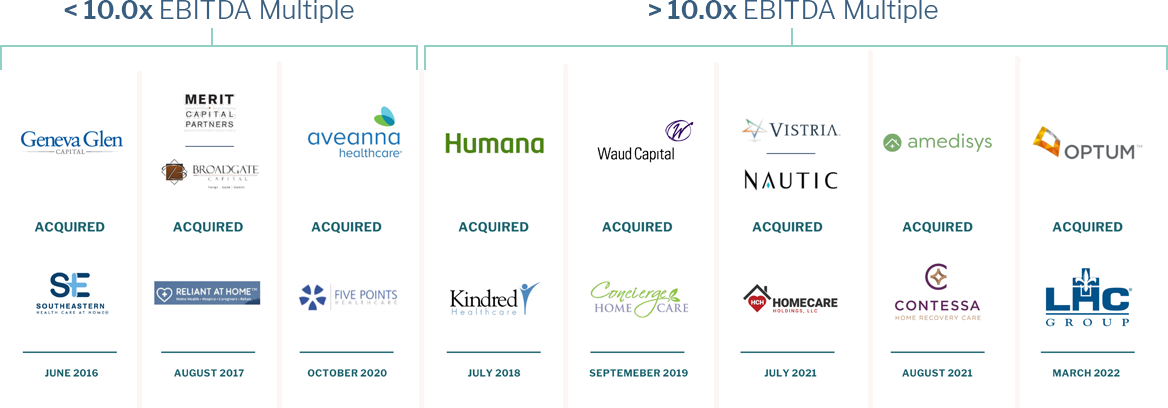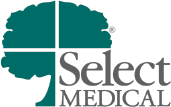Post-Acute Care Market Overview
AUGUST 2023
AUGUST 2023
The U.S. post-acute care (PAC) market was valued at over $438 billion in 2022, and is expected to reach nearly $696 billion by 2032.
Sources: Publicly available information
Post-acute care includes a number of services providing functional recovery for patients following hospitalization, and serves as a bridge for these patients to reach recovery and avoid unnecessary hospital readmission.

Home Health Agencies (HHA)
Provide care for homebound beneficiaries who require skilled, intermittent nursing and therapy care
Inpatient Rehabilitation Facilities (IRF)
Patients who require a combination of hospital-level care and intensive rehabilitation in order to regain the level of function needed to return home
Long-Term Care Facilities (LTCF)
Treat patients with a high level of acuity who require an extended hospital stay
Skilled Nursing Facilities (SNF)
For patients who have received at least three days of inpatient services during the prior hospital stay
Post-acute care services provide a wide range of both medical and non-medical healthcare services.
Approximately 35% of patients discharged from a hospital are admitted to a post-acute setting to receive additional care, while 29% of those are shifted to a secondary post-acute setting

Average cost per patient per day within an acute-care hospital setting is far greater than that of a post-acute venue.

Approximately 35% of patients discharged from a hospital are admitted to a post-acute setting to receive additional care, while 29% of those are shifted to a secondary post-acute setting

Sources: Publicly available information
Post-acute care aims to reduce unnecessary healthcare spending, an objective facilitated by the ongoing transition from fee-for-service to value-based care.

Sources: Publicly available information
|
ACA Expanding Access to Medicare and Medicaid
|
The ACA has improved home healthcare accessibility in the U.S., giving more people the option to utilize this form of care. |
|
Aging Population
|
The aging population in the US is projected to steadily grow, increasing chronic disease cases and opportunities for home care. |
|
COVID-19 pandemic subsiding
|
Elderly patients with underlying conditions are becoming more relaxed over virus fears and opening their doors to home care workers. |
|
Emphasis on Value-Based Payment Models
|
Payors are favoring value-driven reimbursement models that prioritize quality care. |
|
Potential Private Equity Regulation
|
The SEC is proposing potential changes to tighten reporting regulations for private equity players. |
|
Narrow Payor Mix
|
The lack of diversity in the sector’s payor mix poses a direct threat to companies’ margins, which can be significantly impacted by a change in legislation. |
|
Staffing
Demand |
The increased aging population in the US has increased demand for PAC care workers. PAC is also competing with hospitals for these aides, who offer better pay and benefits. |
|
Wage Increases
|
Industry wages have grown an annualized 3.9% to $55.9 billion over the five years prior to 2021. |
Sources: Publicly available information
Aging U.S Population It’s estimated that by 2030, approximately 20% of Americans will be over the age of 65
Fragmented Market Investment in PAC has accelerated, however, the space remains highly fragmented
Rising Inpatient Discharges Referrals to PAC agencies continues to increase
Rising Inpatient Discharges Referrals to PAC agencies continues to increase
Medicare Advantage Enrollment Rapid growth in MA enrollment is poised to overtake Medicare coverage as a whole
Together, they are driving heightened investor interest in PAC amongst financial sponsors and strategic buyers alike...


1) PitchBook
Acquisition activity remains healthy as public and private operators continue to acquire and partner with regional players.
|
Long-Term Acute Care (LTAC) |
Inpatient Rehabilitation Facilities (IRF) |
Skilled Nursing Facility (SNF) |
Home Health Agency (HHA) |
|
|
Footprint
|
||||
670+ locationsacross 41 states |
150+ locationsacross 37 states and Puero Rico |
270+ locationsacross 12 states |
38 locationsacross 5states |
|
|
Lead Sponsor(s)
|
||||
| Publicly Traded NYSE: BKD Market Cap: $792mm |
Publicly Traded NYSE: EHC Market Cap: $7.12Bn |
Publicly Traded NASDAQ: ENSG Market Cap: 5.48Bn |
 |
|
|
Acquisition Count1
|
||||
2Add-ons / |
12Add-ons / |
28Add-ons / |
6Add-ons |
|
1) Acquisition count period evaluated from FY2020-YTDJul2023
Several key valuation factors influence whether a platform trades above or below the double-digit multiple threshold.

Sources: AMB proprietary data
Regulatory requirements are a major challenge faced within the post-acute care space, influencing reimbursement, revenue cycle management and more.
| Service | LTCFs | IRFs | SNFs | HHAs |
|---|---|---|---|---|
| Physician Staffing Requirement |
Supervise medical care of each patient Daily patient examination On duty / on call at all times |
Supervise medical care of each patient Patient examination, face-to-face visit 3x/week On duty / on call at all time |
Supervise medical care of each patient Arrange provision of physician services 24hrs/day (emergency) Patients must be seen at least once within 30 days following admission, once every subsequent 60-day period |
Establish, review and revise each patient’s treatment plan Medicare requires a face-to-face visit 90 days before or 30 days after initiation of home health care, by either a physician or nurse practitioner |
Sources: Publicly available information
Post-acute care cost and coverage varies considerably based on a multitude of factors including: level of care, acuity level and the public or private insurance coverage.
| Home Health Agencies | Skilled Nursing Facilities | Inpatient Rehabilitation Facilities | Long-Term Acute Care Facilities | |
|---|---|---|---|---|
| Reimbursement | 30-day episodic care | Per diem | Per discharge (varies based on patient condition) | Per discharge (varies based on patient condition) |
| Primary Payors | Medicare and Medicare Advantage | Medicare and Medicare Advantage (beginning day 21 of stay, patient has co-payment) | Medicare (FFS) | Medicare, Medicare Advantage and Medicaid |
| Average Cost of Care Per Day | $30 - $5641 | $325 | $500-$1,0001 | $1,500 |
| Average Length of Stay (Days) | Stay based on number of visits; average number of in-person visits range from 11 to 161 | 251 | 13 | 30 |

Type: Long-Term Care
Ownership: Public (NYSE: SEM)
Net Revenue: $6.5bn
Facilities: 2,765
States: 46

Type: Inpatient Rehabilitation
Ownership: Public (NYSE: EHC)
Net Revenue: $4.6bn
Facilities: 150
States: 37

Type: Skilled Nursing
Ownership: Public (OTC: GENN)
Net Revenue: $3.9bn
Facilities: 341
States: 24

Type: Skilled Nursing
Ownership: Public (NYSE: BKD)
Net Revenue: $2.9bn
Facilities: 672
States: 41

Type: Long-Term Care
Ownership: Private (LifePoint)
Net Revenue: $7.1bn
Facilities: 79
States: 25

Type: Inpatient Rehabilitation
Ownership: Public (NYSE: EHC)
Net Revenue: $3.4bn
Facilities: 290
States: 13

Type: Home Health
Ownership: Public (NAS: AMED)
Net Revenue: $2.2bn
Facilities: 514
States: 39

Type: Home Health
Ownership: Private (United)
Net Revenue: $2.3bn
Facilities: 861
States: 38
Post-acute care deal velocity reached all-time highs in 2020, and has remained elevated despite the transition from pandemic to endemic.
| Date | Target | Acquirer | Description | |
|---|---|---|---|---|
| August 2023 |  |
acquired by |  |
Berkshire Homecare and MyCare at Home provide home care and hospice services in theMidwestern U.S. |
| July 2023 |  |
acquired by |  |
PurposeCare is a portfolio company of Lorient Capital, providing home based care services to more than 3,000 clients a month. |
| May 2023 |  |
acquired by |  |
Benefit Health Care provides personal care, companionship, homemaking, and respite care services in Colorado. |
| April 2023 |  |
acquired by |  |
Summit Home Care offers orthopedics, neurology, infusion, summit care management, and hospice services in the Midwestern U.S. |
| March 2023 |  |
acquired by |  |
Home Sweet Home In-Home Care provides in-home senior care, Alzheimer’s and Dementia care, and safety and technology services in Michigan. |
| March 2023 |  |
acquired by |  |
Prosper Home Care serves clients eligible for services within the Elderly Cand Disabled Waiver Program, such as the CCSP and SOURCE programs. |
| February 2023 |  |
acquired by |  |
Prosper Home Care serves clients eligible for services within the Elderly Cand Disabled Waiver Program, such as the CCSP and SOURCE programs. |
| February 2023 |  |
acquired by |  |
Amedisys’ personal care footprint includes 13 care centers in three states – HouseWorks is backed by InTandem Capital Partners. |
| January 2023 |  |
received investment from |
 |
Founded in 2011, Family Tree Private Care provides quality private care experiences for long-term aging at home. |
| January 2023 |  |
received investment from |
 |
HouseWorks provides older adults and their families the highest standard of private, dependable in-home care. |
| December 2022 |  |
acquired by |  |
The Care Team offers hospice care and home health services in Michigan, Pennsylvania, Texas and Massachusetts. |
| December 2022 |  |
acquired by |  |
Geriatric Specialty Care provides high-quality, comprehensive in-home healthcare services to seniors all across Northern Nevada. |
| November 2022 |  |
acquired by |  |
PurposeCare is a portfolio company of Lorient Capital, providing home based care services to more than 3,000 clients a month. |
| November 2022 |  |
acquired by |  |
Kenosha Visiting Nurse Association provides home health care, private duty and community services throughout the Kenosha community. |
AMB focuses on lower middle-market healthcare niches where consumerism and fragmentation meet to disrupt traditional healthcare channels. We typically advise companies with EBITDA of $5M to $20M and an average enterprise value of $100M, but will move up and down the spectrum. AMB’s research-oriented approach to business development has resulted in a vast network of strategic and financial sponsor relationships that yield industry leading intelligence and optimal outcomes for our clients.
Managing Director
843-501-2183 Direct
mikel.parker@ambadvisors.com
Managing Director
843-405-1108 Direct
ryan.loehr@ambadvisors.com
Vice President
843-371-8596 Direct
johnny.cross@ambadvisors.com
Analyst
843-473-7981 Direct
kevin.williams@ambadvisors.com
Analyst
843-576-4709 Direct
sully.hagood@ambadvisors.com
Analyst
843-405-1112 Direct
josh.hall@ambadvisors.com